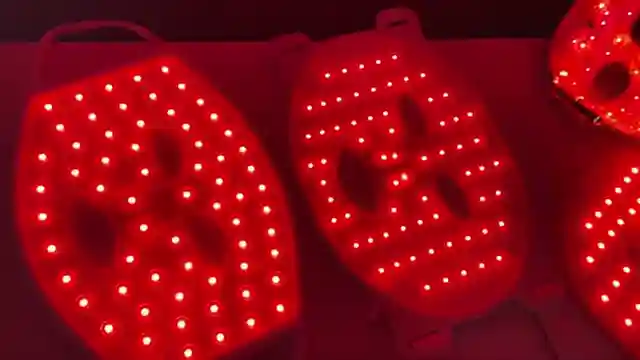Unlocking Skin Secrets: Red Light Therapy Explained

- Authors
- Published on
- Published on
In this riveting episode of Lab Muffin Beauty Science, the team delves deep into the mysterious world of red light therapy, uncovering its remarkable effects on the skin. Red light, absorbed by skin cells' mitochondria, acts as a powerhouse, revving up energy production and accelerating healing and cell regeneration processes. The varying wavelengths of red light, particularly the 633 NM and 660 NM found in LED skin products, play a crucial role in determining the therapy's effectiveness. Meanwhile, near-infrared light, with its penetrating abilities, emerges as a potential game-changer in skin treatment, reaching deeper layers for enhanced results.
As the discussion heats up, the spotlight shifts to blue light at 415 NM, renowned for its acne-fighting prowess but also notorious for darkening post-acne marks. Dose, a critical factor influenced by fluence, power, and treatment duration, emerges as a key player in the success of light therapy. The Bunsen Rosco law of reciprocity challenges the notion that total dose reigns supreme, emphasizing the significance of both the amount and duration of light exposure. Moreover, the AR Schools law highlights an optimal range of light intensity for maximum benefits, cautioning against the perils of too little or too much light.
The debate intensifies as the team scrutinizes the choice between small panels and masks for light therapy. While panels offer cost-effectiveness and versatility, masks provide portability but may vary in comfort and fit. Ultimately, the key takeaway resonates loud and clear: consistency in light therapy usage is the golden ticket to unlocking its cumulative effects, regardless of the device at hand. So buckle up, folks, as Lab Muffin Beauty Science navigates the twists and turns of red light therapy, shedding light on the secrets to radiant skin and the power of harnessing the right dose of luminosity for optimal results.

Image copyright Youtube

Image copyright Youtube

Image copyright Youtube

Image copyright Youtube
Watch The Science of Red Light Masks on Youtube
Viewer Reactions for The Science of Red Light Masks
Viewers appreciate the honesty and realness of the content creator, especially in discussing personal challenges like ADHD and trichotillomania
Positive feedback on the educational and informative content of the video
Comments on the effectiveness of red light therapy for acne, rosacea, and pain relief
Concerns about the impact of red light therapy on eye health
Requests for more information on DNA repair enzymes in skincare and microcurrent technology
Appreciation for the in-depth analysis and research provided in the video
Personal experiences shared, both positive and negative, with red light masks
Compliments on the quality of the video production and educational value
Requests for more content on related topics like glycerin as a dupe for hyaluronic acid and the process of making vitamin D through red light exposure
Humorous comments and references made by viewers, such as the "powerhouse of the cell" joke and comparisons to a thrash metal band.
Related Articles

Top Viral Skincare Products Reviewed: Exfoliation, Makeup Removal, and Soothing Hydration
Lab Muffin Beauty Science reviews viral skincare products from Stylevana, featuring innovative ingredients like sponge spicules and fermented centella extract. Discover top picks for gentle exfoliation, effective makeup removal, and soothing hydration, all tested for safety and reliability.

Sunscreen Secrets: Harmful Ingredients, DIY Alternatives, and Sun Protection Tips
Lab Muffin Beauty Science exposes harmful sunscreen ingredients and advocates for DIY alternatives. Experts discuss the importance of lifestyle sun protection strategies and debunk myths about antioxidant supplements. They recommend mineral sunscreens with non-nano zinc oxide while providing evidence-backed options like tomatoes and leafy greens for enhanced sun protection.

Skincare Innovations: Red Light Masks, Spicules, and Vitamin C Updates
Lab Muffin Beauty Science explores skincare innovations like iRestore's red light mask, spicules in VT Reedle shot, and updates on vitamin C formulas. Discover the latest trends and safety considerations in skincare technology.

Unlocking Hair Protection: Receipt Experiment Reveals Product Efficacy
Lab Muffin Beauty Science tests heat protectants on receipts to determine effectiveness. Water, alcohol, and surfactants impact color changes, revealing insights into product efficacy for hair health.
